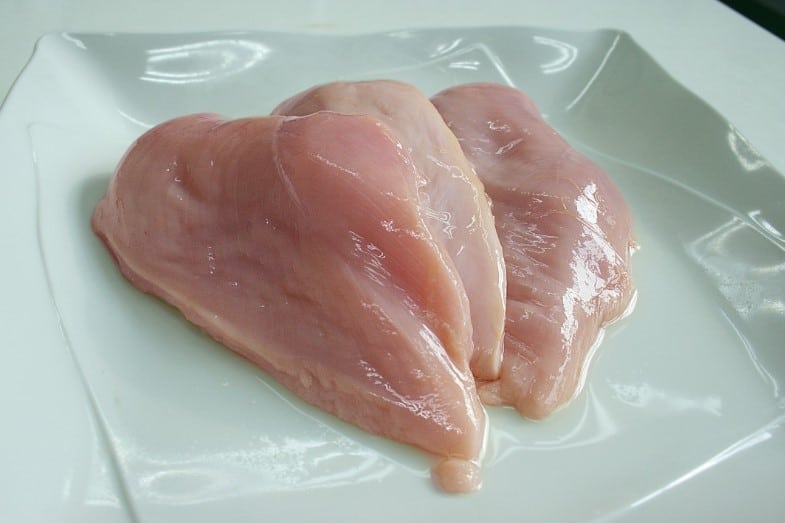Chicken is nutritious, delicious, and can be used in so many recipes. But it is important for your safety that you don’t eat it past its expiry date. In this article, I’ll describe how long chicken can last in the fridge so that you and your family can eat it safely.
How long does chicken last in the fridge and still be safe to eat? According to the U.S. Department of Agriculture (USDA), raw chicken can be kept in a fridge for 1 to 2 days. Cooked chicken can be kept in a fridge for 3 to 4 days. This is a fridge with a proper temperature of 40° F (4° C).
You can’t always determine by smell and sight when the chicken has gone bad. So to be safe, stay within the guidelines set by the USDA.
Read on to learn more about how long chicken can be kept in the fridge, including important storage and handling tips.
How Long Does Chicken Last in the Fridge?
Chicken is the most popular meat in America and one of the most popular meats in the world. The Centers for Disease Control and Prevention (CDC) estimates that approximately 1 million Americans get sick every year from eating poultry.
Very often, raw chicken is contaminated with Campylobacter bacteria and sometimes with Salmonella. To prevent sickness from consuming chicken, you should ensure to keep it refrigerated and consume it before it expires.
Based on the recommendations of the USDA and the U.S. Food and Drug Administration, you should keep raw chicken (whether it is whole, cut into pieces, or ground) no longer than two days in the fridge.
If you have taken the chicken from the freezer and transferred it to the fridge, this timeline will go into effect after it has fully defrosted. Cooked chicken on the fridge, on the other hand, will still be safe to eat after 3 to 4 days.
At room temperature, bacteria and other foreign contaminants cause raw chicken meat to spoil. Once spoiled, the meat is unsafe to eat. There is a considerable reduction in bacterial growth at lower temperatures below 40°F (4°C). Therefore, storing raw chicken inside the fridge will keep it fresh for about 1 to 2 days – as long as the refrigerator is kept no higher than 40°F (4°C).
Additionally, storing raw chicken in leak-proof containers will prevent its juices from contaminating other foods. In the same regard, you should store cooked chicken in airtight containers.
Raw Chicken in Fridge for 7 Days – Is It Safe to Cook and Eat?
Proper Storage
Store chicken in the back or middle of the fridge. Do not put it in the door of the fridge as when you open and close the fridge door; the chicken will warm up.
If you think you can’t cook the chicken within one or two days, you should store it in the freezer to extend its viability. When kept inside the freezer, it is possible to make raw chicken meat edible from nine months to one year, depending on whether it is as a whole or cut in pieces.
You can keep any cooked chicken for 2 to 6 months in the freezer, and it will still be good to eat. Moreover, you can still consume leftover chicken within 3 to 5 days in a fridge running at 0 to 3°F.
How long will chicken last in the fridge? Usually, our common sense of sight and smell can determine if the chicken or other poultry is safe to eat. However, you don’t know what is going underneath its flesh.
So, play it safe. Stick to the recommendations of the USDA and the USFDA. Keep raw chicken refrigerated no longer than 1-2 days. Keep cooked chicken refrigerated no longer than 3-4 days.
How Long Can Cooked Chicken Last in the Fridge?
It can be inevitable to have leftover chicken after meals. And it is a waste of good food if you let it spoil. By keeping the chicken inside the fridge, you can preserve it and eat it tomorrow or the day after that.
However, you need to remember the day you placed the chicken inside the fridge. If you are careful with its storage, it should still be edible within 3 to 4 days. That is true for any cooked chicken, whether broiled, fried, mixed in a salad dish, home-cooked, or from a fast-food joint.
Again, if you have chicken leftovers and can’t consume them within four days, store them inside the freezer. No matter where you will store the leftovers, it is always best to use airtight containers, such as zip locks, resealable plastic storage bags, and sealed plastic or metal containers.
How to Tell If Raw Chicken Is Spoiled?
Do you know the signs of spoiled raw chicken? Besides the foul smell, what else can you tell if it isn’t good to eat anymore? Here are some signs that indicate if raw chicken meat is still good or not.

1. Look at the Color
Pink is the color of real fresh chicken. If it is still fine, it should have a fleshly color. Raw chicken that is beginning to spoil often exhibits a grayish color. Therefore, when the chicken’s skin is starting to become dull, cook it right away before it goes bad. Also, watch out if the color of the skin is already grey. You can’t eat that kind of meat anymore – even if you cook it.
2. Feel the Skin and Flesh
Give the chicken the ‘touch test.’ If it feels slimy to the touch, it is already spoiled. While chicken skin may have a slightly slimy feel, when you rinse it with water, it will go away. If it remains slimy, the chicken is already bad. Additionally, if the skin feels somewhat sticky, don’t cook it anymore.
3. Smell It
If you can’t ignore that strong odor, the chicken is most likely spoiled. The smell could be described as sour. It could also be the smell of ammonia. Whatever kind of odor registers in your nostrils, any foul odor means the chicken is already spoiled. You should throw it away.
We’ve answered ‘how long will chicken last in the fridge’: 1 to 2 days for raw chicken and 3 to 4 days for cooked chicken. And we have looked at how to tell if raw chicken is spoiled. But what about frozen chicken? Next, let’s look at how to tell if frozen chicken is spoiled.
How to Tell If Frozen Chicken Is Spoiled?
Before cooking, always inspect frozen chicken for any signs of spoilage. You may feel doubtful if the best-by date indicated on its package is true or not. So, how long is chicken good for in the fridge?
Here’s how you can inspect frozen chicken.
1. Examine the Color
It is more difficult to check the color of frozen chicken, so you need to be careful. Frozen chicken is similar to the color of raw chicken with yellowing of fat or a slight gray. But if it is darker than gray, it is no longer safe to eat.
2. Check for Ice Crusts
Are there thick ice crusts around the body of the chicken? These thick layers of ice mean the chicken is already bad. It means that the chicken has been stored for a long time inside the freezer that ice crusts have already formed around it. Flash-frozen chicken doesn’t have thick ice crusts, too.
3. Look for Freezer Burn
You will know if freezer burn develops in the chicken if it has white ice. The chicken will have a white rash or mark, which isn’t chicken fat. Moreover, the ice is slightly raised and is rougher than the skin of the chicken. It may not contain harmful pathogens, but you will not enjoy eating it.
How to Tell If Cooked Chicken in the Fridge Is Bad?
You may assume that if you store cooked chicken inside the fridge even for a long time, you can still eat it by reheating it, and it won’t do you any harm. That is not always true. It depends on how long the chicken stays in the fridge.
How can you tell if cooked chicken is good or bad? The following 4 ways can be used to check if it is safe.
1. Smell It
While it is more difficult to smell cooked chicken if it has seasonings and spices, you can still sense the odor of sulfur or rotten egg if it has gone bad. The rotten smell will almost always overcome the scents of spices and seasonings.
2. Check for Mold
If you see that mold has already formed in some parts of the chicken, you can no longer eat it. That means it has already overstayed in the fridge. Black fuzz, green matter, and any kind of organic growth indicate that the chicken is not safe for consumption anymore.
3. Look at the Color
If the chicken was cooked white and now looks grayish, that means it is no longer edible. The color test may not be easy with breaded and marinated chicken because its skin color has been altered. In such cases, do the other tests.
4. Do the Taste Test
It won’t harm you if you taste the chicken first before swallowing it. You can do this if you don’t want to throw a questionable chicken leftover. Take a small bite of the chicken. If there are no unusual reactions in your tongue, or if the taste is still good, it is probably safe to eat. But if it tastes sour and different than when you stored it in the fridge, it has already gone bad for sure.
How Long Can Raw Chicken Last in the Fridge – USDA Guidelines
You can ensure that raw chicken will be of the best quality if you follow the recommendations of the USDA and USFDA. How long is raw chicken good for in the fridge? The simple table below will serve as a reminder and guide for its storage:
| Chicken Type | Fridge | Freezer |
| Chicken, raw, whole | 1 – 2 days | 1 year |
| Chicken, raw, cuts and pieces | 1 – 2 days | 9 – 12 months |
Consider the following recommendations of the USDA:
- Newly bought chicken should be kept in the freezer if you will not cook it right away. The chicken will last for a long time if it is continuously frozen until you thaw it. Therefore, once you get home, immediately put it inside the freezer. It will cryogenize the chicken and stop the elements from aging it.
- When you decide to eat the chicken, take it out of the freezer in the morning and move it to the fridge. The chicken will thaw out inside the fridge but not go below 40°F. That is the secret. Bacteria can only multiply if the temperature is hotter than 40°F. When you get home from work at night, you will have a chicken ready for cooking.
- The marking of expiry dates is not required in poultry. But many stores usually mark “sell-by“ or “use-by” dates. The chicken may still be edible within the given date, but its quality goes down. So, be sure that your fridge does not go higher than the temperature in which bacteria multiply. You should also track the “age” of the chicken in your fridge.
What Can Happen If You Eat Spoiled Chicken?

Bacteria can grow, multiply, and contaminate chicken from their gut, feet, and skin during processing or dressing. Ice and water also contribute their share in the equation. Chilling it after processing minimizes the growth of microbes. But it has no beneficial effect on the chicken since its skin stays moist.
Storing the chicken at low temperatures reduces the reproduction rate of bacteria. However, chicken meat still becomes slimy and smelly because of cold-resistant bacteria like Pseudomonas, which eventually cause spoilage.
If you eat spoiled chicken meat, you will suffer food poisoning. If bacteria such as Salmonella, Campylobacter, and others are present, chicken meat can cause foodborne illnesses. To minimize the risks, you should not eat spoiled chicken meat.
While reheating the meat can kill surface bacteria, it won’t remove certain toxins produced by the bacteria. These toxins can also cause food poisoning. You will know if the chicken caused food poisoning if you have the following symptoms:
- High fever of more than 101°F (38.6°C)
- Vomiting
- Nausea
- Chills
- Dehydration
- Bloody stools
You may even need treatment in the hospital if you have acute and life-threatening symptoms. The best mode of action is to avoid eating any kind of spoiled food – chicken meat included. Cooking spoiled chicken meat over and over again cannot and will not remove its dangers.
Conclusion – How Long Is Chicken Good for in the Fridge?
So, to recap, how long does chicken last in the fridge? You can safely store raw chicken in your fridge for 1 to 2 days. This duration is the recommendation of the United States Department of Agriculture. On the other hand, you can keep cooked chicken in the fridge and still be edible for 3 to 4 days.
How long can chicken last in the fridge? On average, if the meat still smells and looks good, you can still eat it. But to be safe, follow the guidelines set by the USDA.


![How Long Does DayQuil Last? [How Long It Stays in Your System] how long does dayquil last](https://howchimp.com/wp-content/uploads/2021/06/how-long-does-dayquil-last-300x200.jpg)
![How Long Does DHL Take to Deliver? [DHL Delivery Time] How Long Does DHL Take to Deliver](https://howchimp.com/wp-content/uploads/2021/05/how-long-does-DHL-take-to-deliver-300x200.jpg)


